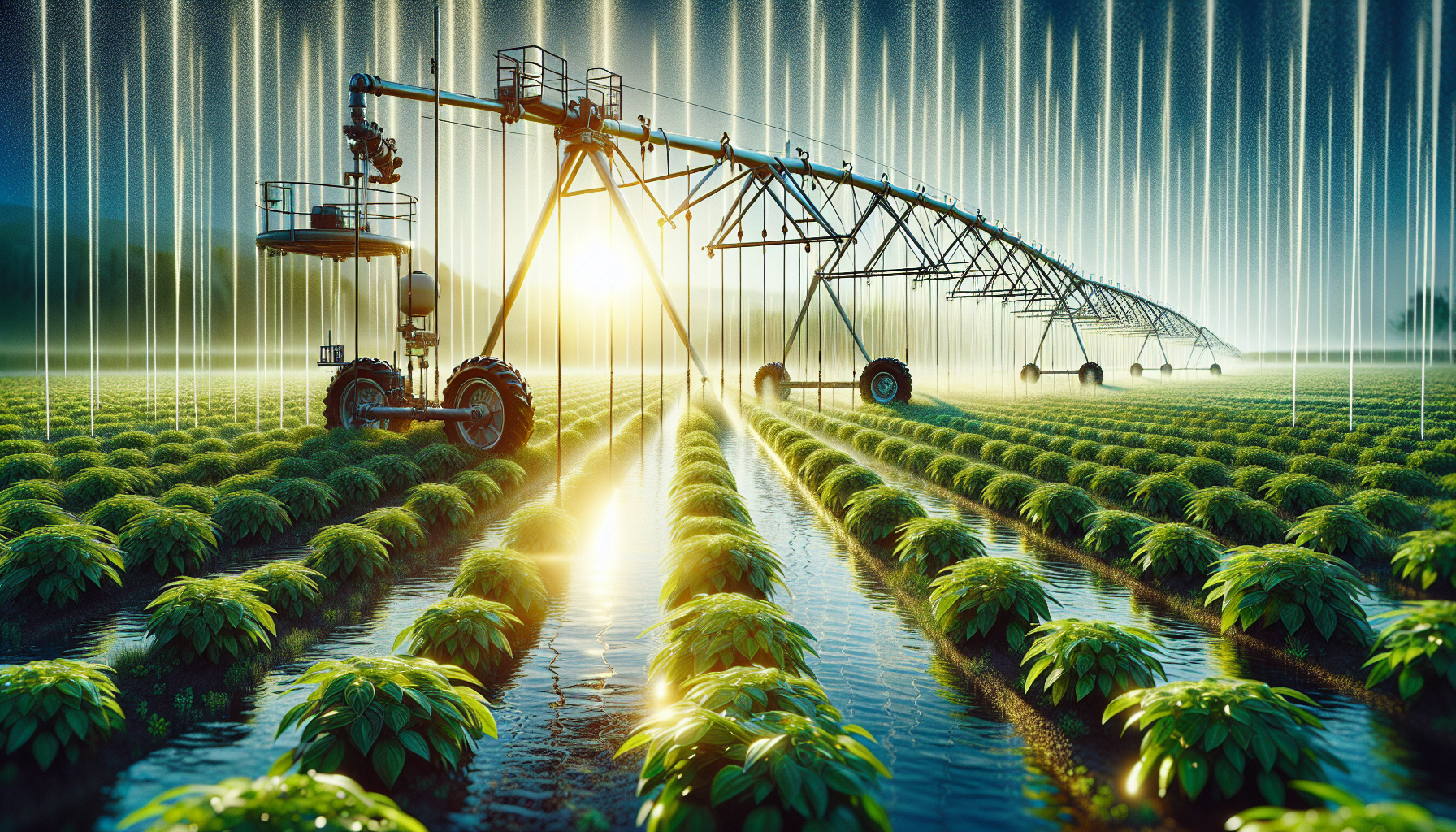In the vast realm of agriculture, where the earth’s bounty is coaxed from the soil through hard work and innovation, one element reigns supreme: water. It’s the lifeblood of crops, the invisible thread that ties together every successful harvest. Yet, in a world where climate change is making weather patterns increasingly unpredictable, and where the pressure to produce more with less is ever-growing, efficient water management has become not just a best practice, but a necessity. 🌿 This is where irrigation pumps, the unsung heroes of modern agriculture, come into play. As farmers and agricultural businesses strive to maximize yields and ensure sustainability, choosing the right irrigation pump can make all the difference.
Imagine a scenario where every drop of water counts, where the timing, volume, and distribution of water could spell the difference between a bountiful harvest and a disappointing yield. That’s the reality many farmers face today. Irrigation pumps are not just tools; they are strategic assets that can transform the way water is managed on a farm. But with a myriad of options available, from centrifugal pumps to submersible ones, how does one make the right choice? What are the key factors that determine the efficiency and performance of these pumps? And how can you ensure that your investment in an irrigation pump pays off in the form of increased productivity and sustainability?
This comprehensive guide will delve into these questions, exploring the intricacies of irrigation pumps and the pivotal role they play in modern agriculture. We will start by examining the different types of irrigation pumps available, highlighting their unique features, advantages, and ideal applications. From there, we’ll navigate through the critical considerations one must take into account when selecting a pump, such as energy efficiency, capacity, and compatibility with existing irrigation systems. You’ll gain insights into the latest technological advancements that are setting new standards in the industry, as well as practical tips for maintenance and optimization to ensure your pump operates at peak performance.
By the end of this article, you will not only have a clearer understanding of how to choose the right irrigation pump for your needs but also how to integrate it into a broader strategy for sustainable water management. Whether you are a seasoned farmer looking to upgrade your equipment or a newcomer eager to learn the ropes, this guide promises to equip you with the knowledge to maximize your harvest and make every drop of water count. So, let’s embark on this journey to unlock the potential of your crops and secure a more prosperous future for your farm. 🌾
Understanding the Importance of Efficient Irrigation Pumps
Efficient irrigation is crucial for maximizing agricultural yields, especially in regions where water scarcity is a pressing issue. The primary role of irrigation pumps is to ensure that water is delivered effectively to crops, reducing wastage and enhancing growth. As the global demand for food increases, farmers must adopt technology that supports sustainable and productive agricultural practices. This section delves into why efficient irrigation pumps are pivotal for modern farming and the broader implications for food security and environmental sustainability.
Water is a finite resource, and its management is more critical than ever. With the increasing frequency of droughts and changing climate patterns, farmers must be equipped with tools that allow them to use water judiciously. Irrigation pumps play a vital role in this, as they help in the precise application of water to plants. By adopting top-performing pumps, farmers can ensure that their crops receive the right amount of moisture at the right time, reducing the risk of overwatering or underwatering. This precision in water management translates into healthier crops, increased yields, and a more sustainable use of water resources.
The benefits of efficient irrigation pumps extend beyond just water conservation. By improving water application efficiency, these pumps contribute to reducing energy consumption on farms. Modern irrigation systems are designed to operate with minimal energy input, ensuring that farmers can lower their operational costs. Furthermore, efficient water use helps in maintaining soil health, as it prevents issues like soil erosion and nutrient leaching, which can occur due to excessive watering. Therefore, investing in high-quality irrigation pumps is not just a decision for today, but a strategic move for the future of farming.
Types of Irrigation Pumps and Their Applications
Irrigation pumps come in various types, each suited to different agricultural needs and field conditions. Understanding the types of pumps available and their specific applications can help farmers choose the most suitable option for their operations. The choice of pump can influence not only the effectiveness of irrigation but also the overall energy consumption and maintenance costs. Here, we explore the main types of irrigation pumps and their ideal applications.
The most common types of irrigation pumps include centrifugal, submersible, and turbine pumps. Centrifugal pumps are widely used due to their efficiency in moving large volumes of water at low pressure, making them ideal for flood irrigation systems and moving water over long distances. Submersible pumps, on the other hand, are used in situations where the water source is deep underground. These pumps are submerged in water and are highly efficient in lifting water to the surface. Turbine pumps are suitable for wells or boreholes and are capable of delivering water at high pressures, which is necessary for certain irrigation systems like sprinklers.
Each type of pump has its advantages and limitations. For instance, while centrifugal pumps are excellent for shallow water sources, they may not be as effective for deep wells. Submersible pumps, although efficient, require more maintenance due to their exposure to water and potential for clogging. Turbine pumps offer high pressure but can be more expensive to install and maintain. Therefore, understanding the specific needs of your farm and the characteristics of your water source is essential in selecting the right pump. To assist in this decision, please refer to the comparative table below.
| Pump Type | Ideal Application | Advantages | Limitations |
|---|---|---|---|
| Centrifugal | Flood irrigation, moving water over long distances | Cost-effective, easy to maintain | Less effective for deep wells |
| Submersible | Deep water sources | Efficient for deep well pumping | Requires more maintenance |
| Turbine | Wells, high-pressure systems | Delivers high pressure | Higher installation and maintenance costs |
Choosing the Right Irrigation Pump for Your Farm
Selecting the right irrigation pump requires careful consideration of several factors, including the size of the farm, the type of crops grown, and the availability of water resources. An incorrect choice can lead to inefficiencies and increased operational costs, so it’s crucial to evaluate the specific needs of your agricultural operation. This section provides a detailed guide on how to choose the best pump for your farm.
One of the primary considerations is the water requirement of your crops. Different plants have varying water needs, and the irrigation pump should be capable of delivering the necessary amount without waste. For example, high-water-demand crops like rice may require pumps that can handle large volumes, whereas drought-tolerant plants might need less frequent watering. It’s essential to calculate the total water requirement per hectare and match it with a pump’s capacity to ensure efficiency.
Another critical factor is the topography of the land. Farms with varied elevation may need pumps with the capacity to deliver water uphill or across uneven terrain. In such cases, pumps with higher pressure capabilities, like turbine pumps, might be necessary. Additionally, the distance from the water source to the fields will influence the choice of pump, as longer distances may require more powerful systems to maintain adequate flow rates.
Considerations for Energy Efficiency
Energy efficiency is a key consideration when selecting an irrigation pump, as it directly affects operational costs. Pumps that require less energy to operate can significantly reduce electricity or fuel expenses, especially on large farms. It’s important to look for pumps with high efficiency ratings and consider the potential for integrating renewable energy sources like solar panels. Some modern irrigation systems come equipped with energy-saving technologies that optimize pump operation and reduce wastage.
Maintenance and Durability
The longevity and maintenance needs of an irrigation pump are other factors that can influence your decision. Pumps that require frequent maintenance can disrupt farming operations and lead to increased costs over time. Therefore, it’s advisable to choose models known for their durability and ease of maintenance. Consider pumps with robust designs and those that offer easy access to parts for repairs. Check out the video below for a demonstration of how to maintain irrigation pumps effectively:
Efficient Irrigation Pump Maintenance – Agriculture Solutions
Innovations in Irrigation Pump Technology
The world of irrigation technology is continuously evolving, with new innovations aimed at improving efficiency and sustainability. Advances in irrigation pump technology are helping farmers maximize their yields while minimizing environmental impact. This section explores some of the latest innovations that are transforming irrigation practices worldwide.
One of the significant advancements in irrigation pumps is the integration of smart technology. Smart pumps are equipped with sensors and controllers that monitor soil moisture levels, weather forecasts, and water flow rates. These systems can automatically adjust watering schedules and pump operation based on real-time data, ensuring optimal water use and reducing waste. This technology not only conserves water but also enhances crop health by providing consistent and precise irrigation.
Another innovative development is the use of variable frequency drives (VFDs) in irrigation pumps. VFDs allow for the adjustment of the pump motor speed, enabling it to operate more efficiently under varying conditions. This technology reduces energy consumption by matching the pump’s performance to the actual water demand. Farmers can benefit from lower electricity bills and extended pump life, as VFDs minimize wear and tear by preventing the pump from running at full capacity when it’s not necessary.
Solar-Powered Irrigation Pumps
With the growing emphasis on sustainability, solar-powered irrigation pumps are becoming increasingly popular. These pumps harness solar energy to power irrigation systems, providing a cost-effective and environmentally friendly alternative to traditional fuel or grid-powered pumps. Solar pumps are particularly beneficial in remote areas where access to electricity is limited. The initial investment in solar technology can be offset by the long-term savings in energy costs and the reduction of greenhouse gas emissions.
- Smart Technology Integration
- Variable Frequency Drives
- Solar-Powered Pumps
In conclusion, efficient irrigation pumps are a cornerstone of modern agriculture, playing a critical role in sustainable water management and food production. By understanding the different types of pumps, their applications, and the latest technological advancements, farmers can make informed decisions that enhance productivity and sustainability. The integration of smart technology, energy-efficient designs, and renewable energy sources is paving the way for a more efficient and environmentally friendly agricultural industry.

Conclusion
Certainly! Here’s a conclusion that fits your requirements:
—
In conclusion, the journey through the intricacies of maximizing your harvest with top-performing irrigation pumps is a vital exploration for anyone invested in agriculture or horticulture. This guide has delved into the various types of irrigation pumps, their specific functionalities, and how they can significantly enhance water efficiency in your farming practices.
We began by exploring the fundamentals of irrigation pumps, emphasizing their pivotal role in ensuring that water is distributed evenly and efficiently across your crops. Understanding the different types of pumps—such as centrifugal, submersible, and turbine pumps—allows farmers to make informed decisions tailored to their specific agricultural needs. Each type of pump brings its own set of advantages, whether it be high efficiency, adaptability to various water sources, or the ability to handle large volumes of water.
Another significant point discussed was the importance of proper maintenance and the use of advanced technologies. Routine checks and timely servicing ensure that the irrigation pumps operate at optimal capacity, reducing the risk of unexpected breakdowns and prolonging their lifespan. Moreover, integrating smart technologies like IoT devices and sensors can transform traditional irrigation systems into intelligent networks that provide real-time data and feedback. This technological advancement enables farmers to optimize water usage, reduce waste, and ultimately increase yield.
Furthermore, the article highlighted the environmental impact and sustainability aspect of using efficient irrigation pumps. As water scarcity becomes an increasingly pressing global issue, adopting efficient watering solutions not only benefits the individual farmer but also contributes to broader ecological conservation efforts. By implementing systems that minimize water wastage, farmers can play a crucial role in conserving this precious resource for future generations 🌍.
The economic benefits cannot be overlooked. Efficient irrigation systems result in lower operational costs, reduced water bills, and increased crop production. This combination leads to a more profitable and sustainable agricultural practice, allowing farmers to reinvest in their businesses and continue to grow.
We also touched upon the critical factors to consider when selecting an irrigation pump, such as the type of crops being cultivated, the scale of operation, and the specific environmental conditions. Tailoring the choice of pump to these factors ensures that the system works harmoniously with the natural environment, optimizing both growth and resource utilization.
In essence, the integration of high-performing irrigation pumps into your agricultural practice is not merely about increasing yield—it’s about creating a balanced, efficient, and sustainable farming ecosystem. The benefits extend beyond individual gain, contributing to a more sustainable food system that can meet the needs of a growing global population.
As we wrap up this discussion, it’s important to acknowledge that the pursuit of efficiency in agriculture is a continuous journey. The field of irrigation technology is ever-evolving, with new innovations and improvements constantly emerging. Staying informed and open to adopting these advancements will empower you to maintain a competitive edge and continue to thrive.
We encourage you to apply what you’ve learned from this guide to your own practices. Experiment, adapt, and observe the changes in your harvests. Sharing your experiences and insights with others in the farming community can also foster a collaborative environment where knowledge is exchanged, and collective progress is achieved.
Please feel free to leave your comments below, share this guide with fellow farmers or agricultural enthusiasts, and join the conversation on how we can all contribute to more efficient and sustainable farming practices. Your input and experiences are invaluable, and together, we can cultivate a future where agriculture thrives in harmony with nature.
For further reading and resources on irrigation technology and sustainable farming practices, you might find the following links useful:
1. U.S. Department of Agriculture – Irrigation
2. FAO – Water and Agriculture
Thank you for engaging with this guide. Here’s to abundant harvests and sustainable futures! 🌱
—
Feel free to adjust any parts as needed, especially the links which need to be verified for their current status and relevance.
Toni Santos is a visual historian and creative artisan whose work channels the bold spirit of the steam-powered era—a time when imagination, mechanics, and ambition converged to reshape the modern world. Through richly detailed visual narratives and handcrafted design, Toni celebrates the legacy of steam innovation as both an artistic and technological revolution.
Driven by a passion for mechanical aesthetics, forgotten inventions, and industrial-age ingenuity, Toni reimagines the world of steam through illustrations, tactile artifacts, and storytelling that capture the poetry of pressure, motion, and invention. From piston-driven engines to brass-detailed diagrams, each piece reveals how steam wasn’t just power—it was promise.
With a background in visual design and historical research, Toni brings a craftsman’s eye and a dreamer’s heart to the stories of tinkerers, inventors, and visionaries who shaped the 19th century. His work doesn’t merely document machines—it honors the culture, courage, and creativity that drove a world to reimagine itself through gears, valves, and vapor.
As the creative voice behind Vizovex, Toni shares curated articles, reconstructed blueprints, and visual interpretations that bring this industrial past to life. His collections serve as a tribute to:
The elegance of steam-era design and innovation
The human stories behind great mechanical feats
The aesthetic beauty found in function and form
The echo of invention in today’s creative world
Whether you’re a history lover, a fan of steampunk, or an admirer of antique technology, Toni welcomes you into a world where art and machinery fuse, one cog, one drawing, one rediscovered marvel at a time.





